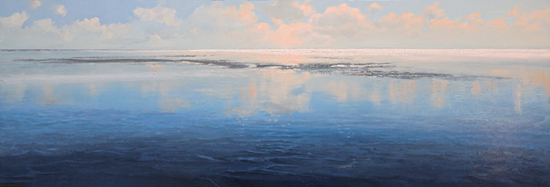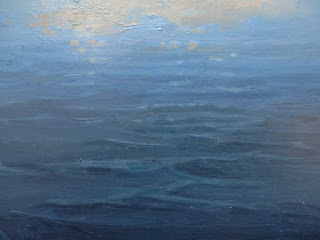In my previous blog entry I mentioned two painting techniques I often use (glazing and impasto). This time I want to talk about two other techniques: one gave it's name to a late nineteenth century art school (Pointillism), the other is about making smooth transitions. I used both techniques in 'Evening Clouds over the Ocean'.
 |
| Evening Clouds over the Ocean, oil on panel, 47.2" x 63" |
The below detail is part of the ocean, just left of the center. It's about 3.5" x 2.5". As you can see I painted a lot (a lot) of dots on top of a purple-ish ground layer. This is not according to the rules of the French Pointillists, who covered their entire painting with dots. The similarity is what is called 'optical mixing'. It means that, seen from a distance, your eyes mix the dots to a single color. The result is a vibrant surface. You'll never get this kind of surface when you mix the color on your pallet. I use it mostly when I paint the ocean to suggest the movement of the water at mid-distance. In my Painting Reflections tutorial you can see an example.
The realism of my work is for the greatest part the result of smooth transitions. Even in the above detail you can see I painted the dots on top of such a transition. The color of the sky is another example. From the left to the right it slowly changes from almost yellow to a dark blue. To achieve this I use a technique called stippling and a badger hair fan brush. In my Painting Clouds video I show how I do it.




